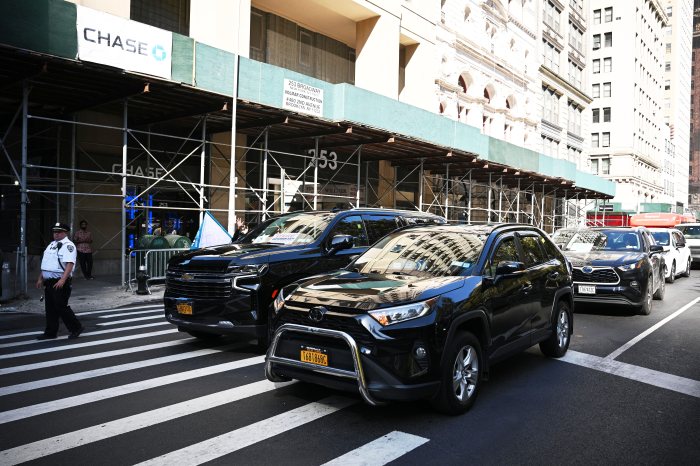-
 The Roosevelt Island Tram is the first tram to be used for mass transit. Berdy explained that the tram was meant to be a temporary means of transportation when it began operation in 1976. At the time, the subway to connect Roosevelt Island and Manhattan was being built, and commuters needed another way to get to the city.
The Roosevelt Island Tram is the first tram to be used for mass transit. Berdy explained that the tram was meant to be a temporary means of transportation when it began operation in 1976. At the time, the subway to connect Roosevelt Island and Manhattan was being built, and commuters needed another way to get to the city.
In 1989, when the subway opened, people were already accustomed to the tram and they decided to keep it as a commuter tramway, Berdy said.
” data-id=”111764849″ data-link=”https://amnewyork.wpengine.com/wp-content/uploads/2019/10/15363_image.jpg” class=”wp-image-1.11764849″/>
Photo Credit: Nicole Brown -
 While the Roosevelt Island Tram is not owned or operated by the MTA, you need a MetroCard to ride it. The fares are the same price as subway or bus fares.
While the Roosevelt Island Tram is not owned or operated by the MTA, you need a MetroCard to ride it. The fares are the same price as subway or bus fares.
The tram is owned by the Roosevelt Island Operating Corporation and operated by Leitner-Poma of America.
” data-id=”111764841″ data-link=”https://amnewyork.wpengine.com/wp-content/uploads/2019/10/20685_image.jpg” class=”wp-image-1.11764841″/>
Photo Credit: Nicole Brown -

Photo Credit: Nicole Brown -
 The Roosevelt Island Operating Corporation estimates that between 2.6 and 2.7 million people ride the tram each year. An average of 5,500 to 6,500 people ride on any given day.
The Roosevelt Island Operating Corporation estimates that between 2.6 and 2.7 million people ride the tram each year. An average of 5,500 to 6,500 people ride on any given day.The tram serves both residents and tourists. While there isn’t data for exactly how many of the riders fall into which category, Robert Wise of Leitner-Poma of America estimates that about 70 percent of the ridership is residents, while 30 percent is tourists.
There are currently about 14,000 residents on Roosevelt Island.
” data-id=”111764848″ data-link=”https://amnewyork.wpengine.com/wp-content/uploads/2019/10/20689_image.jpg” class=”wp-image-1.11764848″/>
Photo Credit: Nicole Brown -

Photo Credit: Nicole Brown -
 With widows on each side of the cabins, passengers get a 360-degree view of the city as they cross the East River.
With widows on each side of the cabins, passengers get a 360-degree view of the city as they cross the East River.
Wise said many TV and movie producers rent out the cabins to film these aerial views.
” data-id=”111764832″ data-link=”https://amnewyork.wpengine.com/wp-content/uploads/2019/10/15371_image.jpg” class=”wp-image-1.11764832″/>
Photo Credit: Nicole Brown -
 The trip across the East River only takes between three and four minutes. The tram travels 3,140 feet at a speed of 10 miles per hour, the Roosevelt Island Operating Corporation said.
The trip across the East River only takes between three and four minutes. The tram travels 3,140 feet at a speed of 10 miles per hour, the Roosevelt Island Operating Corporation said.
It operates from 6 a.m. to 2 a.m. Sundays through Thursdays and from 6 a.m. to 3:30 a.m. Fridays and Saturdays. It makes trips about every 15 minutes.
” data-id=”111764835″ data-link=”https://amnewyork.wpengine.com/wp-content/uploads/2019/10/15374_image.jpg” class=”wp-image-1.11764835″/>
Photo Credit: Nicole Brown -
 The tram was shut down in 2010 for a complete renovation. The cabins, as well as most of the operations of the tram, were replaced. The upgrades were meant to make the tram more efficient and extend operations for at least 30 years, according to the Roosevelt Island Operating Corporation.
The tram was shut down in 2010 for a complete renovation. The cabins, as well as most of the operations of the tram, were replaced. The upgrades were meant to make the tram more efficient and extend operations for at least 30 years, according to the Roosevelt Island Operating Corporation.
One of the major changes was the dual-haul system, which means each cabin can operate independently. One of the benefits of the cabins operating independently is that both can now be at the same station at the same time, making the tram more efficient during peak times.
” data-id=”111764834″ data-link=”https://amnewyork.wpengine.com/wp-content/uploads/2019/10/20691_image.jpg” class=”wp-image-1.11764834″/>
Photo Credit: Nicole Brown -
 If you’re worried about getting stuck in a cabin above the East River, the Roosevelt Island Operating Corporation says you don’t need to be. Part of the renovation put in a wireless retrieval system that is powered by a backup motor. The motors are also equipped with both electric and gas power, Wise explained. He said the technology is very advanced for aerial tramways.
If you’re worried about getting stuck in a cabin above the East River, the Roosevelt Island Operating Corporation says you don’t need to be. Part of the renovation put in a wireless retrieval system that is powered by a backup motor. The motors are also equipped with both electric and gas power, Wise explained. He said the technology is very advanced for aerial tramways.
“We’re probably leading the country in technology.”
” data-id=”111764836″ data-link=”https://amnewyork.wpengine.com/wp-content/uploads/2019/10/15376_image.jpg” class=”wp-image-1.11764836″/>
Photo Credit: Nicole Brown -
 The tram can operate in most weather conditions and has backup generators in place if there are power oputages. During Hurricane Irene and Superstorm Sandy, Wise said the tram was able to operate longer than all other forms of transportation.
The tram can operate in most weather conditions and has backup generators in place if there are power oputages. During Hurricane Irene and Superstorm Sandy, Wise said the tram was able to operate longer than all other forms of transportation.
“The Roosevelt Island Tramway was the last form of public transportation to stay operating and the first to resume operation,” he said.
” data-id=”111764831″ data-link=”https://amnewyork.wpengine.com/wp-content/uploads/2019/10/15380_image.jpg” class=”wp-image-1.11764831″/>
Photo Credit: Nicole Brown -
 The tram drops passengers off at Tram Plaza on Roosevelt Island, where the visitor center is one of the original kiosks for the former “Bridge Local” trolley that connected Queens and Manhattan until 1957.
The tram drops passengers off at Tram Plaza on Roosevelt Island, where the visitor center is one of the original kiosks for the former “Bridge Local” trolley that connected Queens and Manhattan until 1957.
The island also features the Franklin D. Roosevelt Four Freedoms Park, a lighthouse built in 1872, the ruins of the Smallpox Hospital where patients were quarantined in the 1800s, and other landmarks, art galleries and restaurants.
” data-id=”111765560″ data-link=”https://amnewyork.wpengine.com/wp-content/uploads/2019/10/15383_image.jpg” class=”wp-image-1.11765560″/>
Photo Credit: Nicole Brown
The Roosevelt Island Tram is unlike any other form of transportation in the city. Connecting Manhattan, at 59th Street and Second Avenue, to Roosevelt Island, it serves both island residents and tourists alike.
Judith Berdy of the Roosevelt Island Historical Society said the tram, which celebrates its 40th anniversary this year, is known as a safe, clean and energy-efficient form of transportation.
“It’s an icon of the island,” she said.
Scroll down for some facts and figures of the tram.

































